Best known for being the birthplace of Johannes Gutenberg, this historic city on the Rhine River is now the wine capital of Germany. Here are the best things to do in Mainz, Germany in one day!
This post contains affiliate links, from which we may receive a commission. You can read our full affiliate disclosure here.
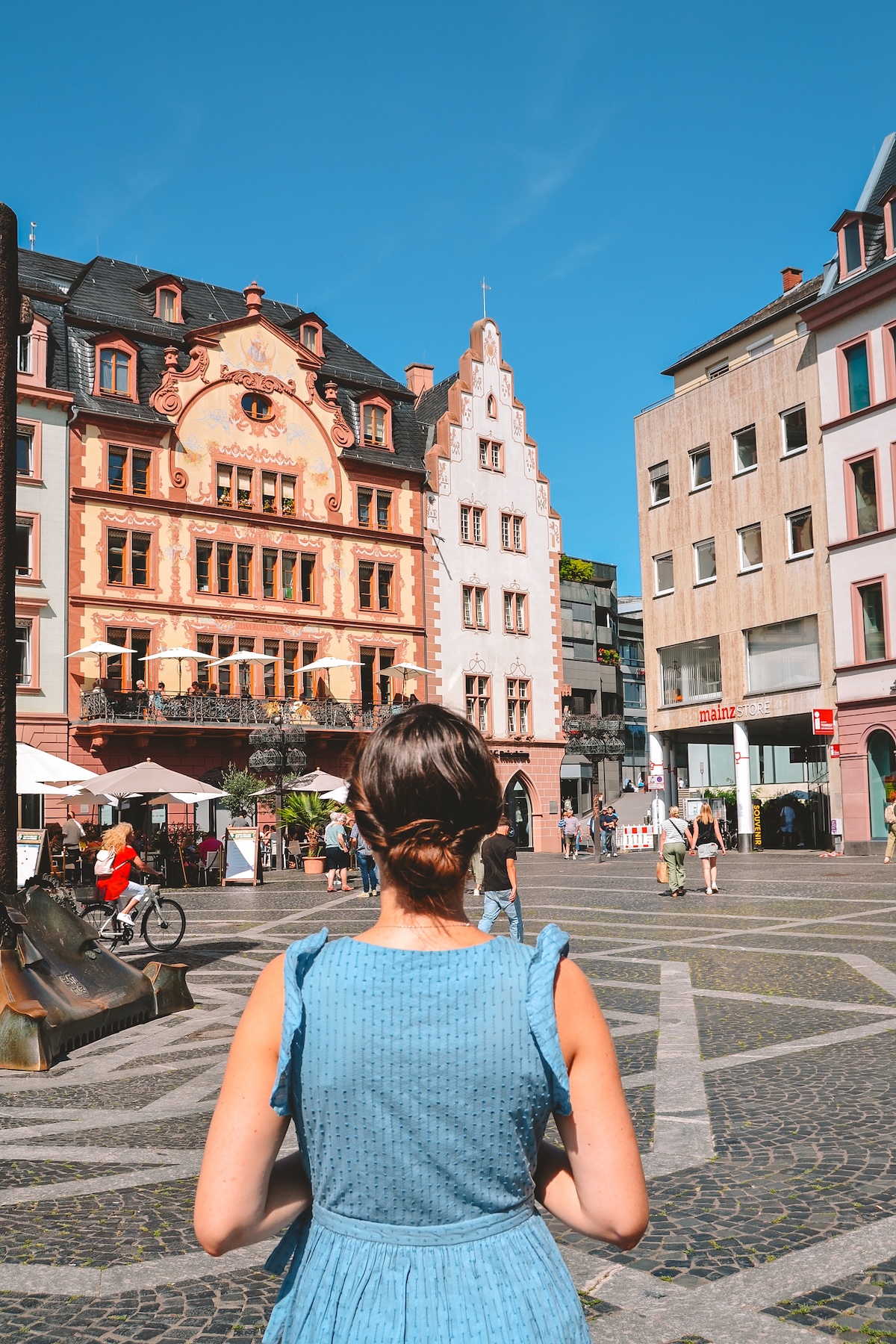
What is Mainz famous for? Well, many things! But its most famous son was Johannes Gutenberg, who invented the printing press with movable type in this very city in 1440.
However, Gutenberg’s revolutionary invention is just one of many important chapters in Mainz’s history. Mainz was first settled by the Romans, and they remained here until roughly 451 CE. In 1118, the city of Mainz gained the rights to self-government.
Throughout the centuries, the city has been occupied by the Romans, French, Swedes, Prussians, and is now part of modern-day Germany. And like many German cities, Mainz was all but leveled during WWII bombing raids and then rapidly rebuilt. Today Mainz is a major media hub and is also considered to be the wine capital of Germany.
This post will share the best things to do in Mainz, Germany as well as answer some FAQs. If Mainz isn’t on your bucket list yet, it will be soon!
-Claire
Mainz Day Trip Itinerary
To make the most of your day spent sightseeing in Mainz, I suggest visiting the city’s top attractions in the order listed below. The inner city is easy to navigate on foot (grab a map at the tourist information center). However, if you paid for a Deutschland Ticket, then all of the public transportation in Mainz is included in the cost of that ticket.
Stop 1: Central Market Square (Marktplatz)
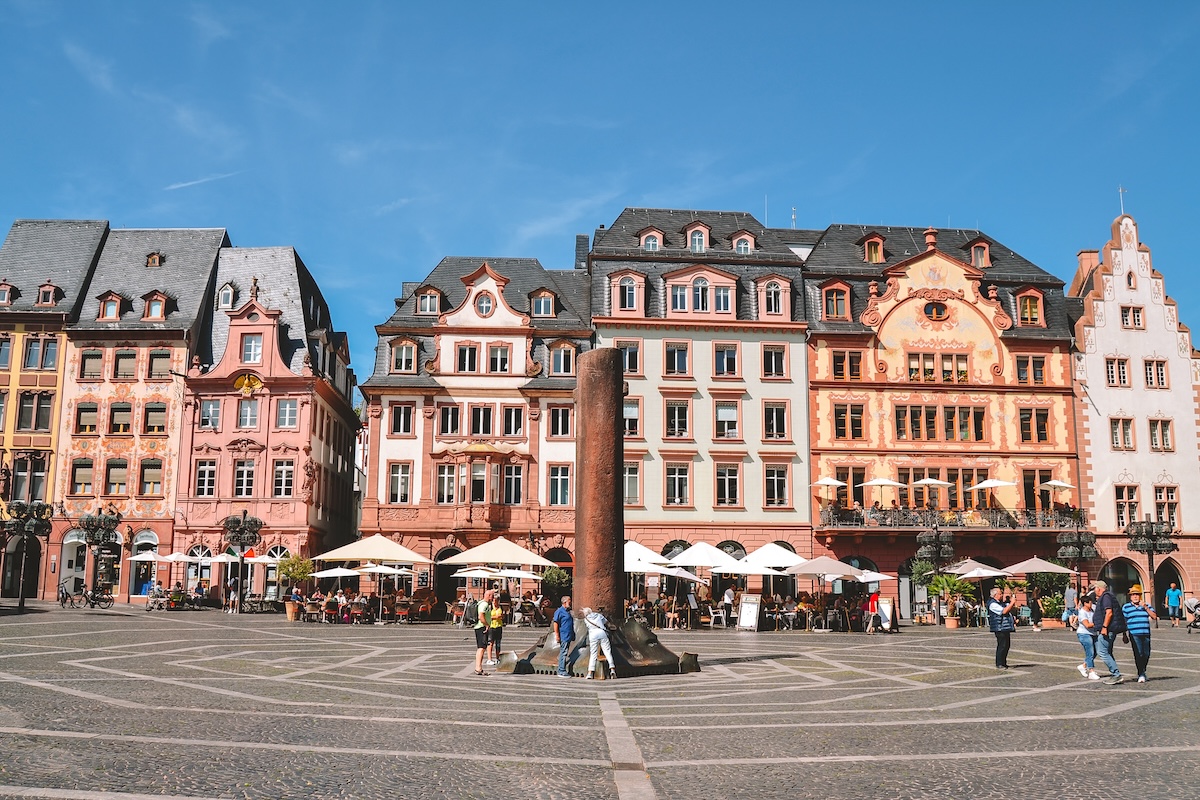
Whether you’re in Mainz for one day or many, it’s impossible to miss the Marktplatz (main square) during your explorations of the city center. The picturesque Marktplatz sits in front of the Mainz cathedral.
One of the can’t-miss sights in Mainz is the enormous sandstone column that’s stood in the center of the Marktplatz since 1975 — although the 16-ton column is believed to be more than 1,000 years old!
The column — called the Heunensäule — was discovered near the Bavarian town Miltenberg and was one of reportedly 14 columns discovered together. It’s believed that the columns were intended for the rebuilding of the Mainz Cathedral, the original structure having burnt down the day that it was consecrated in 1009 AD. The Heunensäule was finally erected in the Marktplatz to celebrate the cathedral’s 1,000th anniversary.
Also note that a weekly market is held at the Marktplatz three times per week (Tuesdays, Fridays, and Saturdays from 7am to 2pm). You’ll find produce, breads, and meats galore, so be sure to bring cash to buy some goodies. Weekly markets in Germany are a feast for the senses, so you don’t want to miss this!
Stop 2: St. Martin’s Cathedral (Dom St. Martin)
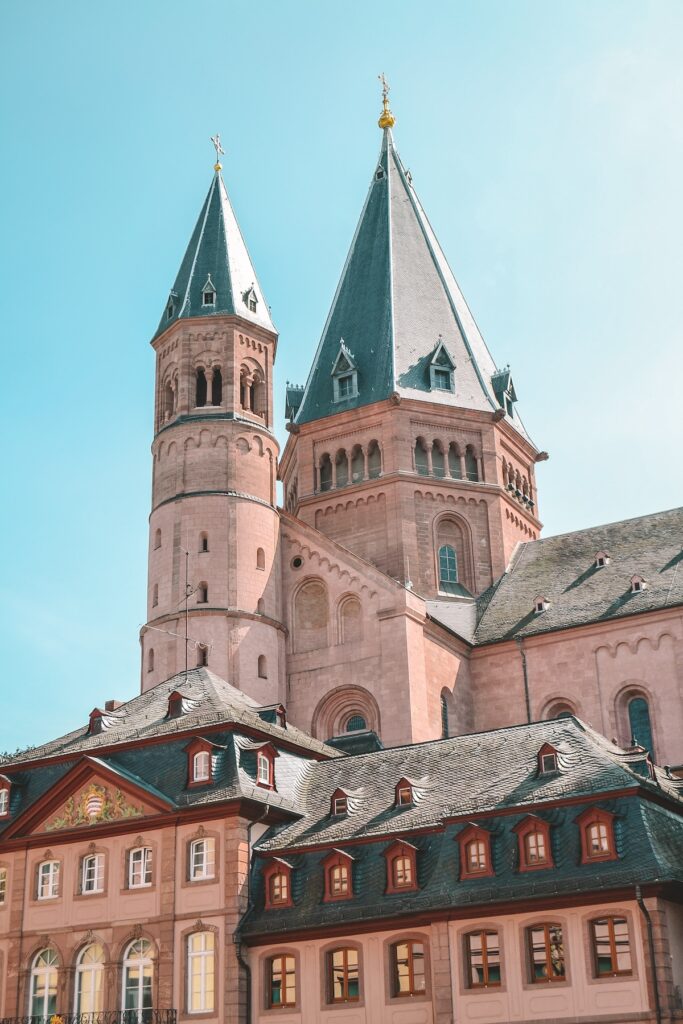
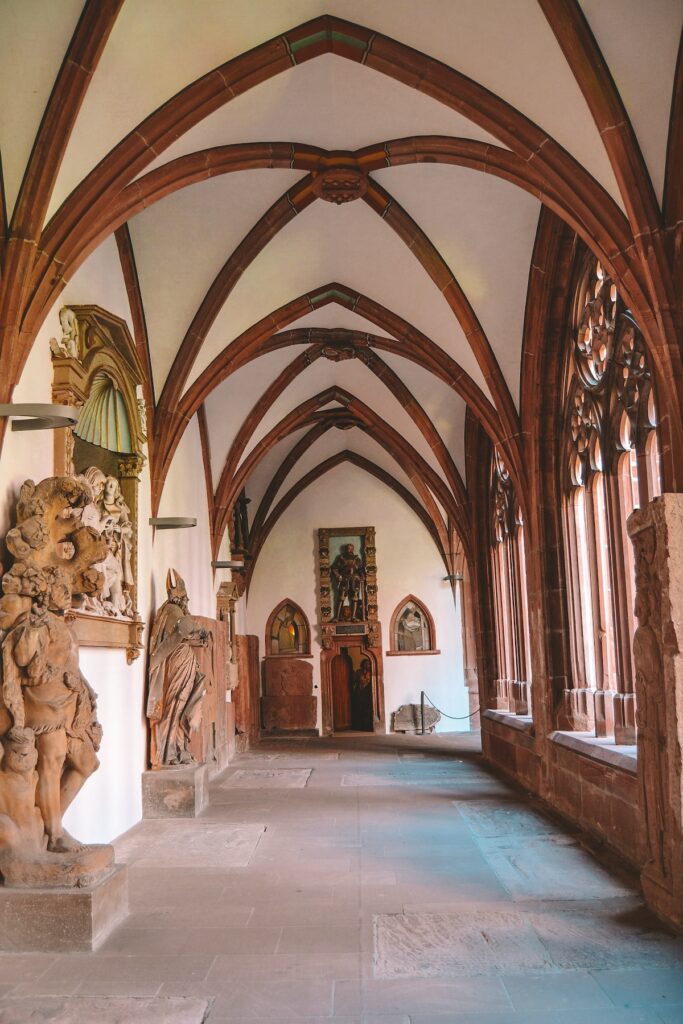
The Mainz Cathedral was built between 975 and 1009 CE. For such an old church, I’m sure it comes as no surprise to hear that it’s been destroyed and rebuilt many times over the centuries.
During the Middle Ages, the Mainz Cathedral was a big deal. The Archbishop of Mainz had the sole right to crown German Monarchs, and six monarchs were crowned at this very place.
The Late Gothic cloisters are a main feature of the cathedral, as are the massive tombs of the archbishops.
Claire’s Tip: You can also pay to visit the Cathedral Museum, which is located right next to the cathedral itself.
Stop 3: Nail Column (Nagelsäule)
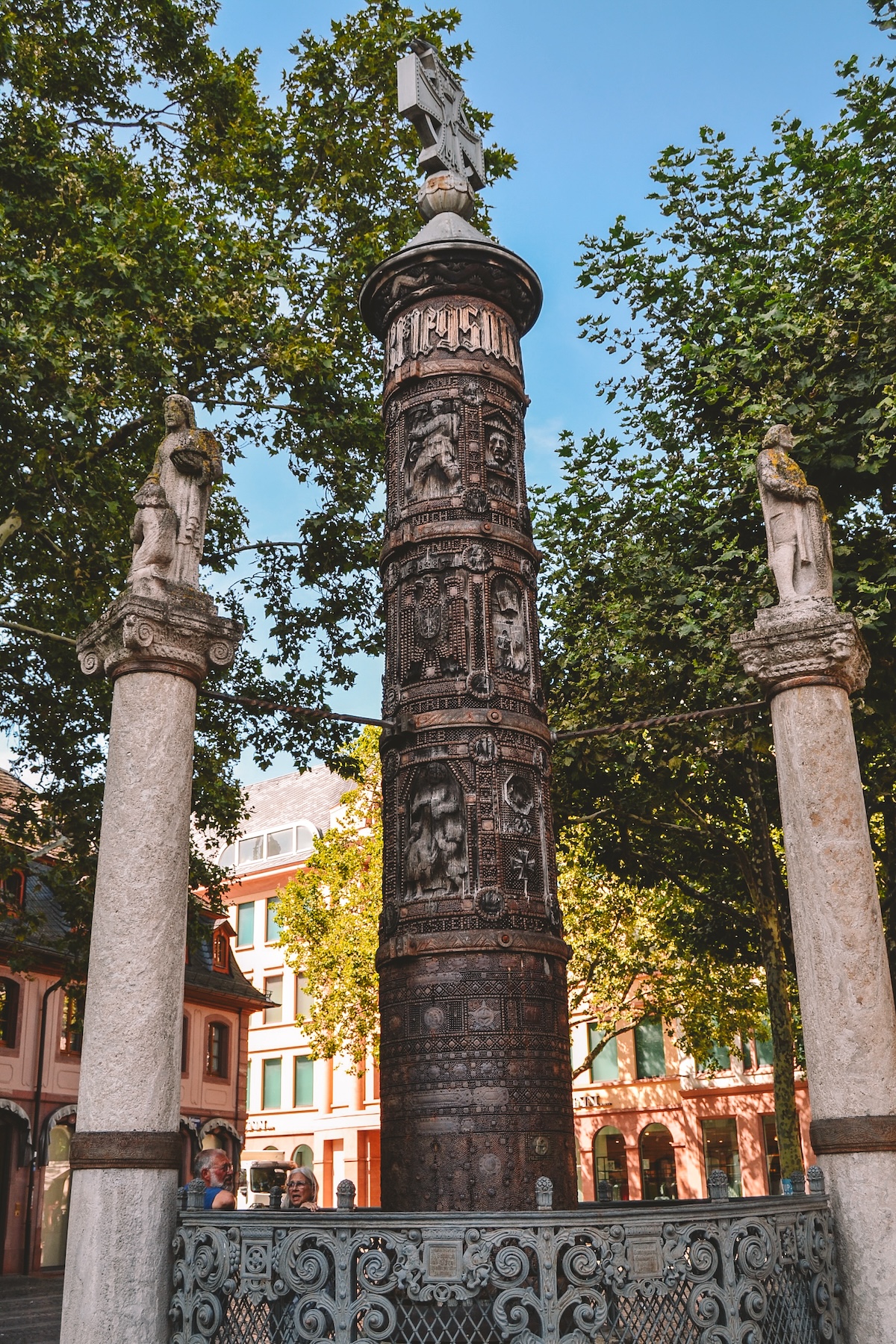
After exploring the inside of the cathedral, head back out the main entrance and pause to look at the Nail Column (Nagelsäule) that’s located on Liebfrauenplatz.
The unique column was erected during World War I as part of the “war nailing” fundraiser campaign. In exchange for a monetary donation to the war efforts, citizens were allowed to hammer one nail into the oak column (per a design that had been pre-approved by the mayor).
The elaborately decorated Nail Column is surrounded by three smaller limestone pillars. The pillars are topped by allegorical representations of Bravery, Unity, and Charity. This is definitely an underrated thing to see in Mainz!
Stop 4: Gutenberg Museum
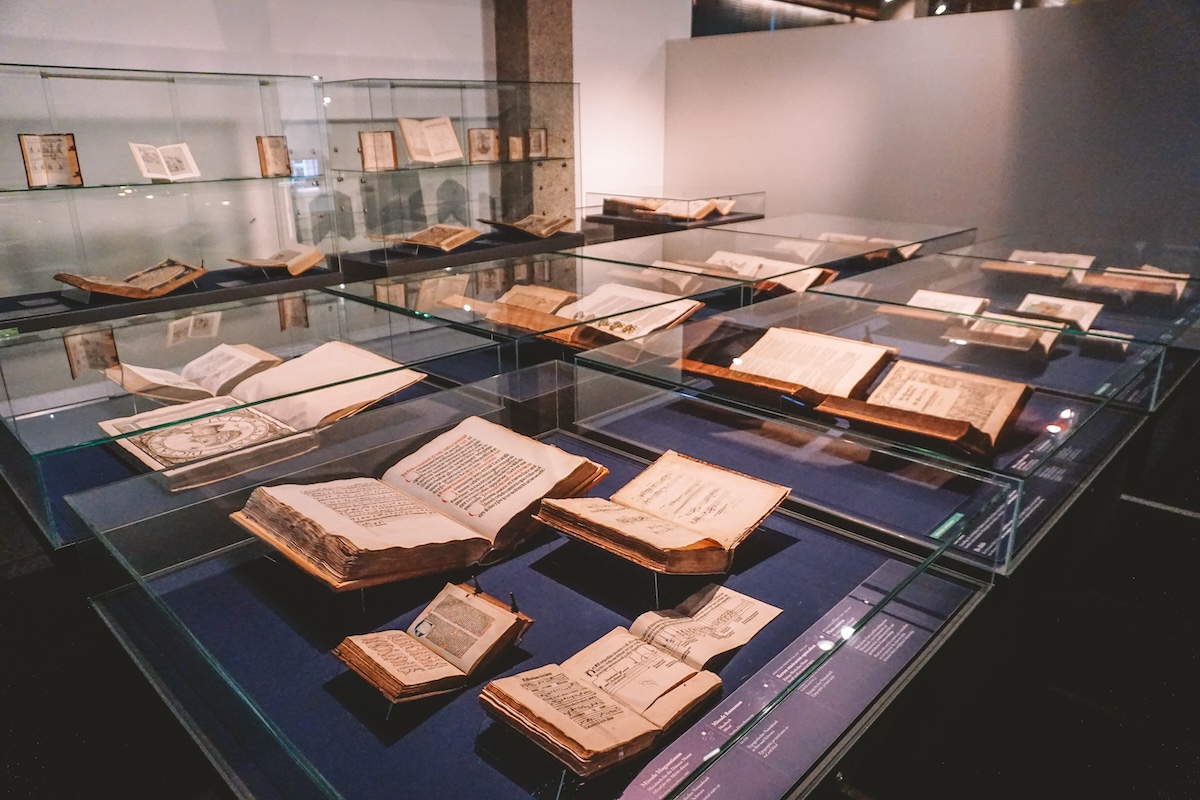
Bookworms will love the Gutenberg Museum in Mainz! This compact museum walks you through the history of books and printing, with an emphasis on Johannes Gutenberg’s legacy and work.
The star attraction of the museum are the two original Gutenberg bibles, which are sealed inside a massive vault and watched by a security guard. The museum is primarily a collection of old books, manuscripts, and printing presses — all of which were lovely to look at, but the accompanying text was quite dry to read (and it was all in German!). But the Gutenberg Bibles … they are works of art in every sense of the word!
There are only 48 Gutenberg bibles left in the world, so definitely take your time examining the two (!!) in the Gutenberg Museum. It’s unlikely that you’ll see another for a long time!
Claire’s Tip: The Gutenberg Museum is mostly in German, but you can download an audio guide to your smartphone for a couple Euros. Also note that this is a small museum; it took me about 90 minutes to go through.
Stop 5: Old Town (Altstadt)
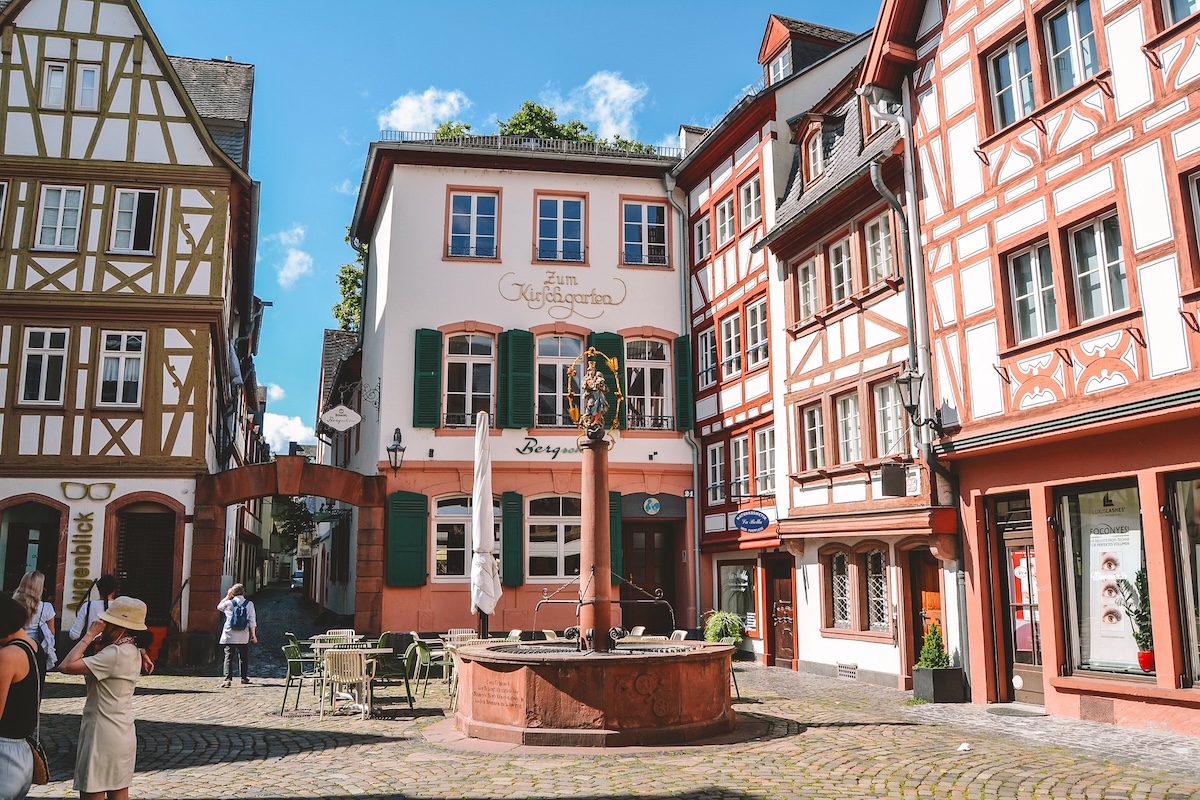
The Old Town (Altstadt) is hands down one of the BEST things to see in Mainz, Germany. The Mainz Old Town is sadly teeny tiny — it’s just one street with a small square — but it’s one of the prettiest old towns that I’ve visited! If you like half-timbered houses, Mainz will be your new favorite city.
The Kirschgarten is a gorgeous square where the oldest half-timbered house in Mainz is located. It dates back to the 15th century! Unfortunately you can’t go inside as it’s now a dentist’s office.
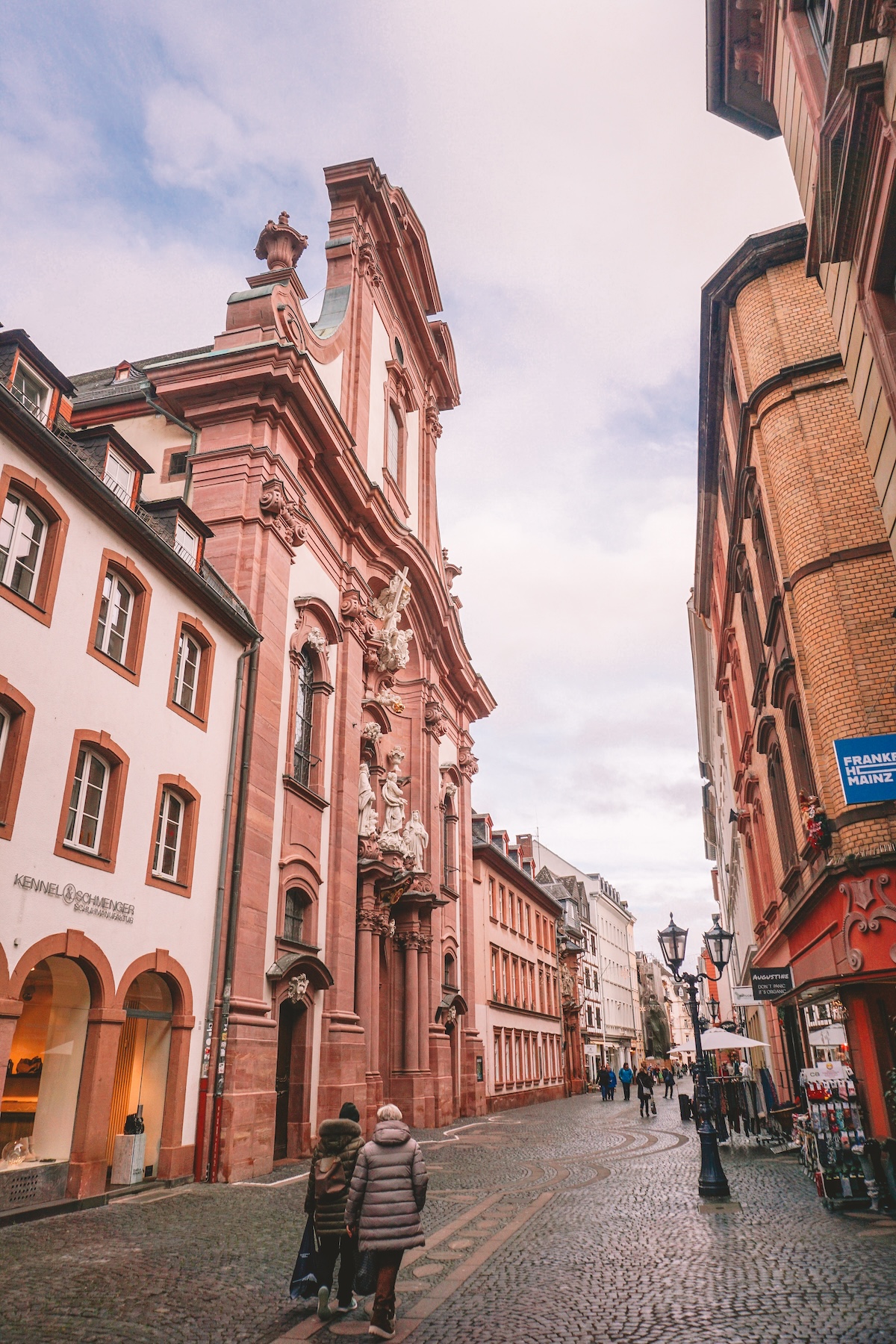
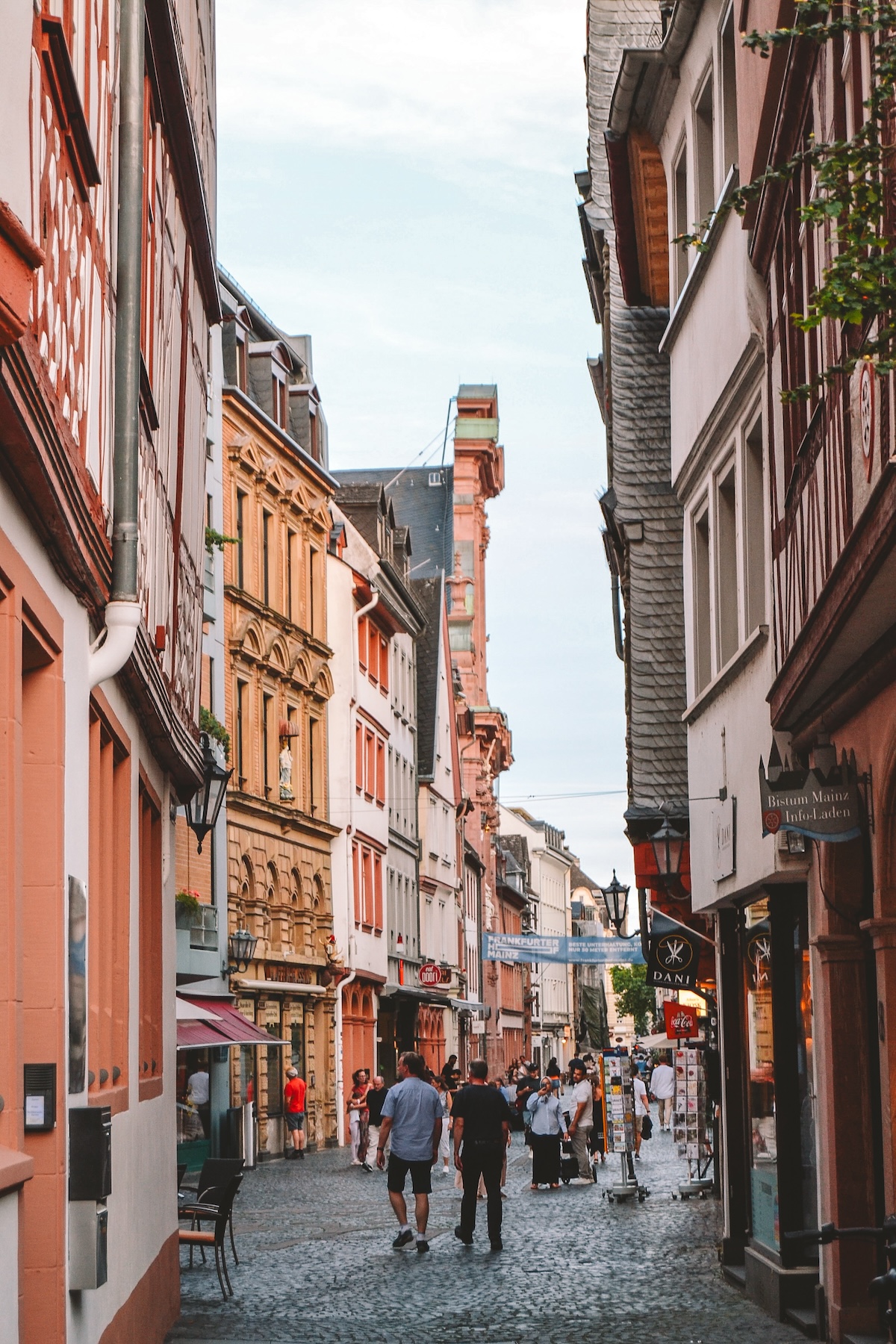
In addition to the many boutiques and cafes within the Old Town, be sure to pop into the St. Augustine’s Church (Augustinerkirche – shown above left). It was built in the late 1700s in the Baroque style and is currently a seminary.
I didn’t see the Augustinerkirche listed as an attraction on any other Mainz guides, which surprised me since it’s such a beautiful church.
Stop 6: St. Stephan’s Church (Stephanskirche)

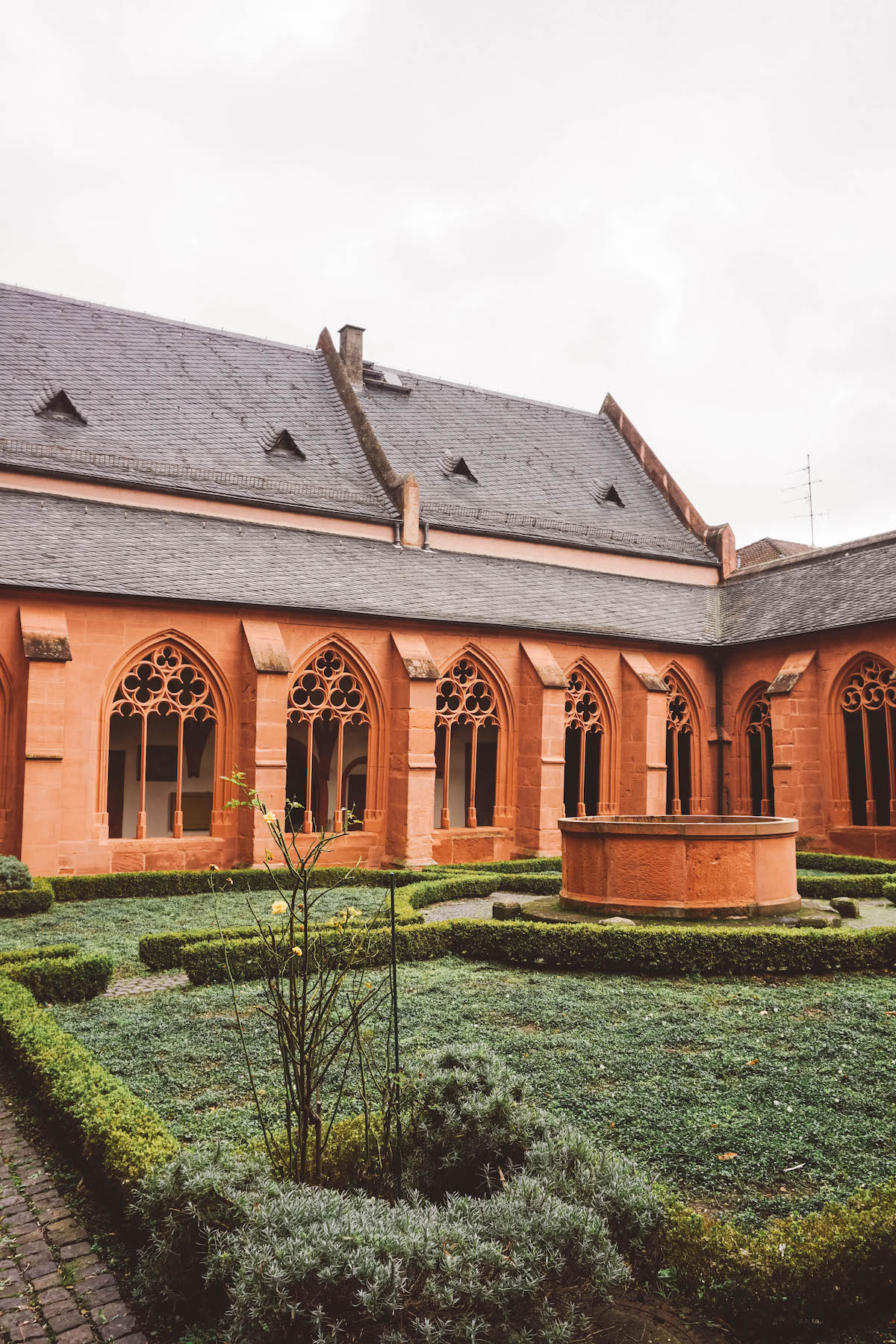
The interior of St. Stephan’s isn’t spectacular — with one major exception. The church is surrounded by blue stained glass windows!
They were created by the Jewish artist Marc Chagall in the 1970s. He made them as a means of illustrating the Jewish-Christian bond, and they’re without a doubt the highlight of St. Stephan’s.
Stop 7: Evening Wine Tasting
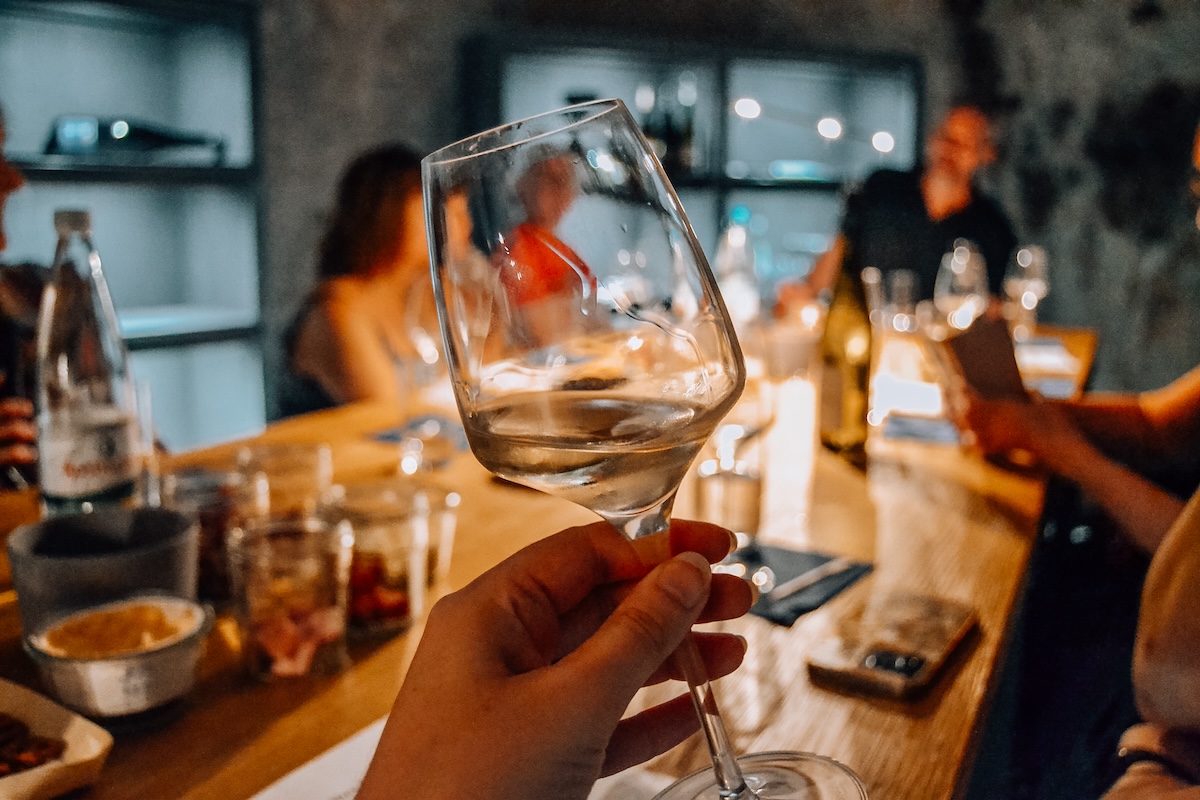
In addition to filling your itinerary with popular sightseeing destinations, make sure to do some kind of wine tasting as well to learn more about the city’s long and fascinating history of winemaking — as well as try the exceptional Riesling and Spätburgunder wines that are produced in the region!
Mainz is the wine capital of Germany, so as you can imagine there are a variety of excellent wine tours and tastings to participate in. I recently had the opportunity to participate in a wine tasting with BottleStops, and it was the perfect way to end a day in Mainz.
Claire’s Tip: I also went on a day tour of the region with Bottlestops the last time I was in Mainz. If you’re looking for more things to do in Mainz and will be in the city for more than a day, consider booking a day tour instead of an evening wine tasting. You can read my full review of Bottlestops’ day tour here.
Seasonal Activity: Visit the Christmas Market
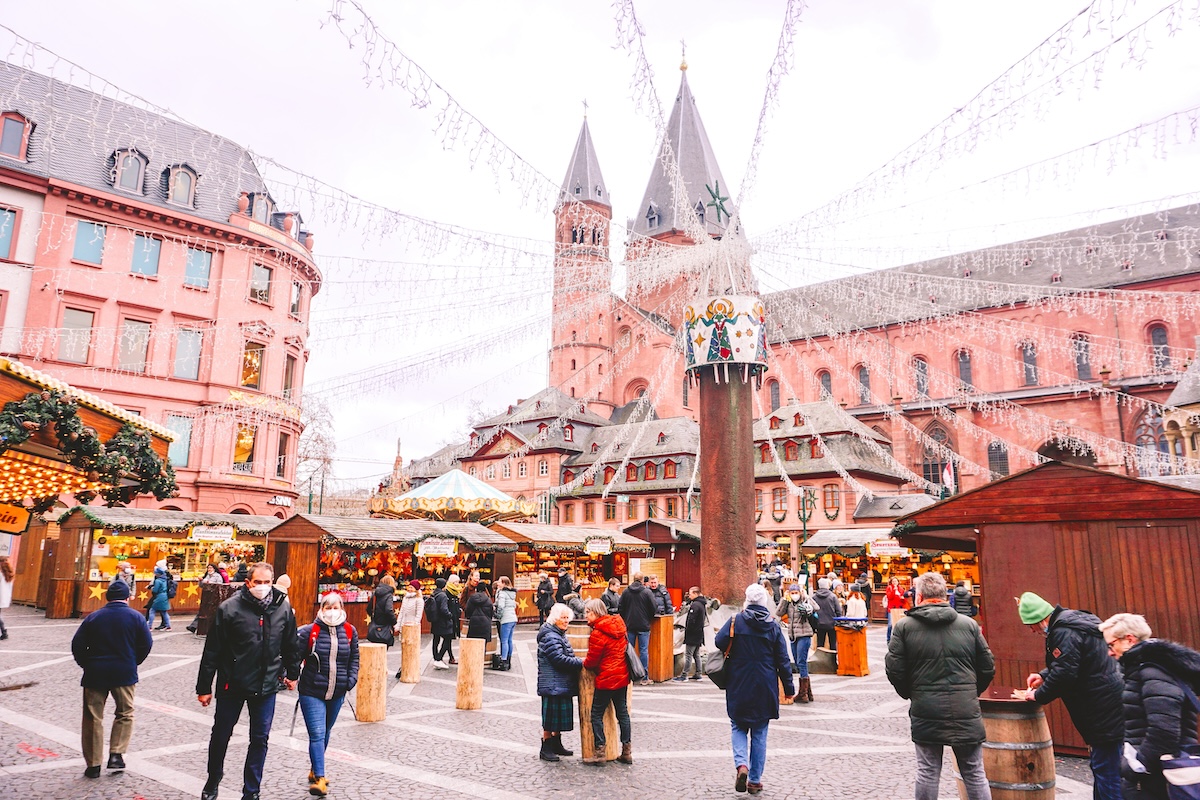
The Mainz Christmas market runs from the end of November through December and takes place in front of the cathedral. The quality of goods for sale here is incredibly high, and the atmosphere was one of the best I experienced during my holiday travels.
Oh, and Look for the Men in the Crosswalk Lights!
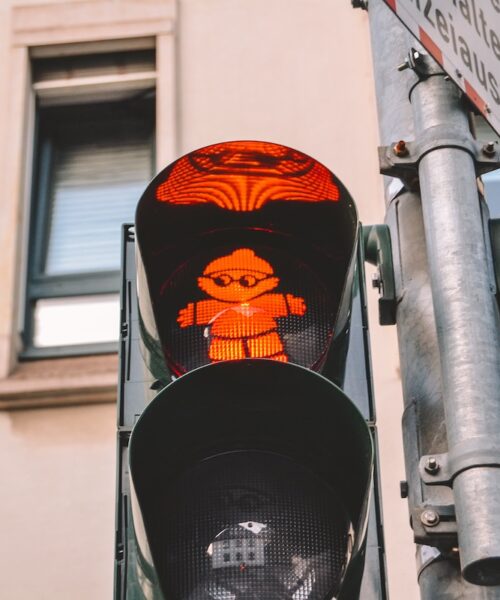
When you cross the roads, take a good look at the crosswalk lights. There are tiny gnomes in them!
Those little gnomes are called Mainzelmännchen, which translates literally to “little Mainz men.” The name is a combination of the city, Mainz, and Heinzelmännchen, which are popular figures in local folklore.
The Mainzelmännchen are mascots for the German broadcast network ZDF, which has its headquarters in Mainz. Hence the gnomes in the crosswalk lights!
Even More Things to Do in Mainz
The list of Mainz tourist attractions I’ve shared above will keep you busy for a whole day and give you time to enjoy a leisurely lunch and / or afternoon coffee (when in Europe, right?).
Other things to do in Mainz that I haven’t personally experienced but have heard good things about include:
- Kunsthalle (Art Hall) — Rotating contemporary art exhibitions.
- Mainz State Museum (Landesmuseum Mainz) — One of Germany’s oldest museums, with an art collection largely donated by Napoleon in 1803.
- Museum of Natural History (Naturhistorisches Museum Mainz) — Specimen collection of animals and fossils.
Another activity that I HAVE experienced firsthand and can highly recommend on sunny days is a leisurely walk along the Rhein Promenade. The river is beautiful, and there are a smattering of cafes and hangout spots along the banks of the river, should you need a break from the city center.
Is One Day in Mainz Enough Time?

I’ve now visited Mainz a couple of times, so I can confidently say that one day in Mainz is plenty of time to see the main attractions. Obviously you won’t be able to go into every single museum and church or participate in multiple tours, but you can definitely explore the bulk of the city center on foot. (For reference, I arrived in Mainz around 11am and left at 7pm on my first ever day trip).
If you’ll be staying for more than a day, consider booking a guided day tour to (safely) drink your way through the surrounding wine region, or utilize Germany’s extensive train network to take a day trip from Mainz.
🚂 The Best Places to Visit Near Mainz (Easy Day Trips by Train) 🇩🇪
Auf Wiedersehen, Mainz!

If you’re considering a trip to Mainz, do it! There’s so much to do and see here, and it’s a wonderful city to visit no matter the season.
Don’t forget to follow me on Instagram to keep up with my daily adventures in Berlin and beyond!

More Places to Visit Near Mainz:
- Top Things to Do in Heidelberg
- What to Do, See & Eat in Düsseldorf
- 13+ Fun Things to Do in Cologne
- What to Do in Bonn (Former Capital of West Germany!)
- All of my Germany recommendations!
Thank you to BottleStops for gifting me a wine tasting and winery tour. All opinions are 100% my own.
Comments & Reviews
Omg the gnomes on the crosswalks are adorable!!! This was such a sweet post, I’ll definitely refer to this article when I visit Mainz!
Right?? They’re like a cuter version of Berlin’s Ampelmann! I think you’ll really like Mainz!
Hi! I’m using Mainz as a homebase for a 4 day trip, can you suggest an itinerary that’s no more than 2 hours away by public transport/car? You seem to be the only blogger who seems to get around to more niche areas, which I really appreciate!
Hi Ari, so glad you find my niche travel guides helpful 🙂 You can definitely take a couple day trips if you’ll be in Mainz for 4 days. Cities nearby that I recommend include: Heidelberg, Bonn, and Frankfurt. (I have guides for both Heidelberg and Bonn, FYI). Of the cities I just mentioned, Heidelberg is my favorite by a landslide so definitely take a day trip there if possible. Enjoy your trip!
Thank you for beautiful photos of the city.
As a German from Mainz, I really have to add that Germany is very very well known for its wine 💪🤗 referring to your comment „since German wine doesn’t have much of a reputation“. Maybe you can read some articles or visit the wine areas in Germany.
E.g. https://genevawinesociety.com/german-wines-along-the-shores-of-the-mosel-and-the-rhine/
Hi Josephine, thanks for your comment! I know Germany is famous for its riesling, but my comment re: its overall reputation is in comparison to better-known wine producing countries like Italy and France. But you’re absolutely right, I need to visit Germany’s wine regions and learn more about its history! I appreciate you leaving a helpful comment encouraging me to learn more about the country I now call home 🙂
Thank you for these pictures and information, which were helpful for my trip planning!
My husband and I will have 1 free day in Mainz on Wednesday, March 5th before our tour officially begins. Could you suggest a local guide or would we be able to just follow your suggestions on our own? We will be staying at the Hyatt Regency from March 5 th to the 7th. Thank you in advance for your help.
Warm Regards,
Lori Basch
Hi Lori! Yes, you’ll be able to easily follow the itinerary outlined in my guide. Mainz has a small but lovely city center that’s easily accessible on foot. The only attraction that’s a little “further out” is St. Stephan’s, which takes approx. 10 minutes to reach from the Old Town. If you’re a wine lover, I highly recommend booking a wine tasting with BottleStops (the owner Jerome is very nice!) or a similar company in advance of your visit since that type of activity can sell out in advance. Enjoy your time in Mainz!
I wonder if you actually saw the Gutenburg Bibles because they are not included in a museum visit. They can only be seen with special reservations on a tour that costs an additional 12€.
Hi Andrea! Yes, I definitely saw them within their vault and had a wonderful conversation about them with one of the guards on duty that day. However, museum policies are subject to change so it’s possible that I viewed them before a new rule or tour went into effect. I’ll reach out to the museum this week to confirm and will update this guide if needed. Thanks for flagging!